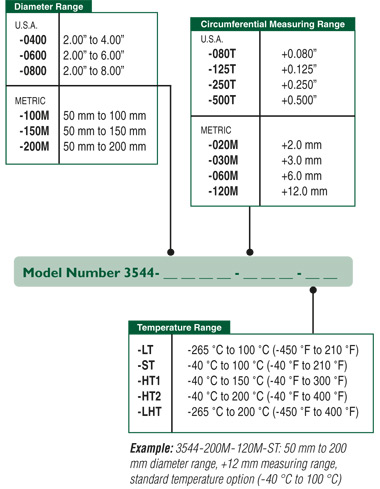Epsilon Model 3544 circumferential extensometers provide measurements of circumference changes of a specimen when it is compressed.
According to most researchers, measuring the circumference changes by this way is treated as a more accurate approach for diametrical strain measurement because measurement is performed on the entire material inside the circumference.
Epsilon Model 3544 circumferential extensometers are intended for compression tests on other large samples or for rock and concrete compression testing. They can be used in combination with the Model 3542RA axial extensometers. The output can be set to zero with a mechanical adjustment.
The Model 3544 extensometer is mounted to the specimen using a high precision, custom roller chain with special rollers, which makes the unit to expand to accommodate increasing specimen diameter during the test.
Self-supporting on the sample by means of integral springs, the extensometer can handle different size samples through the addition or removal of links.
The Model 3544 extensometer is protected by means of a breakaway device in the event of specimen failure. Testing of rock samples is often carried out in tri-axial pressure cells. Versions of the Model 3544 can be fit within the vessel and are capable or operating in oil environments at up to 200°C and 1360 bar. They can also be fit within small inner diameter vessels.
The Model 3544 is ideally suited for large diametral strains in large compression samples. It is recommended to use Epsilon Model 3975 diametral rock and concrete extensometer for small strain measurements such as Poisson's ratio.
As a strain gauged device, the Model 3544 extensometer shows compatibility with any electronics engineered for strain gauged transducers. It is often coupled to a test machine controller. The signal conditioning electronics are typically integrated into the test machine controller or may often be included for the extensometer.
In this case, the unit is supplied with the appropriate connector and wiring for direct plugging into the electronics. Epsilon provides a range of solutions for units without the required electronics, allowing connection of the extensometer output to charter recorders, data acquisition boards, or other devices.
Epsilon MODEL 3544 Circumferential Extensometers
Model 3544-0400 with 2.00 inch to 4.00 inch diameter range
Model 3544 in a horizontal body style
Model 3542RA Dual Averaging Extensometer with Model 3544 Circumferential Extensometer
Key Features
The key features of the Model 3544 extensometer include:
- Self-supporting on the specimen
- Rugged, dual flexure design for strength and improved performance
- Full bridge, 350Ω strain gaged design for compatibility with nearly any test system
- Versions available for use in tri-axial confining pressure cells, at high pressures and temperatures
- May be used concurrently with Model 3542RA axial extensometers
- Includes high quality foam lined case
- Adapts to a wide range of specimen sizes by adding or removing chain links
Model 3544 Available Versions
The Model 3544 extensometer is available in any combination of temperature range, measuring range and diameter as shown below:

Epsilon offers other configurations upon special order.
Options
Options available include horizontal, vertical, or user convertible orientations and connectors to interface to virtually all brands of test equipment.